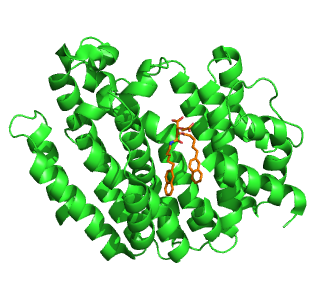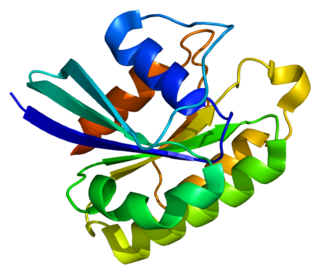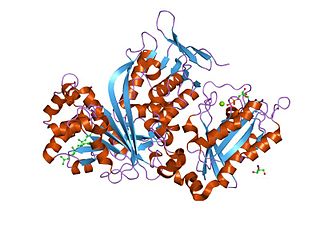Related Research Articles

Protein primary structure is the linear sequence of amino acids in a peptide or protein. By convention, the primary structure of a protein is reported starting from the amino-terminal (N) end to the carboxyl-terminal (C) end. Protein biosynthesis is most commonly performed by ribosomes in cells. Peptides can also be synthesized in the laboratory. Protein primary structures can be directly sequenced, or inferred from DNA sequences.

Lipid-anchored proteins are proteins located on the surface of the cell membrane that are covalently attached to lipids embedded within the cell membrane. These proteins insert and assume a place in the bilayer structure of the membrane alongside the similar fatty acid tails. The lipid-anchored protein can be located on either side of the cell membrane. Thus, the lipid serves to anchor the protein to the cell membrane. They are a type of proteolipids.
The C-terminus is the end of an amino acid chain, terminated by a free carboxyl group (-COOH). When the protein is translated from messenger RNA, it is created from N-terminus to C-terminus. The convention for writing peptide sequences is to put the C-terminal end on the right and write the sequence from N- to C-terminus.
The Rab family of proteins is a member of the Ras superfamily of small G proteins. Approximately 70 types of Rabs have now been identified in humans. Rab proteins generally possess a GTPase fold, which consists of a six-stranded beta sheet which is flanked by five alpha helixes. Rab GTPases regulate many steps of membrane trafficking, including vesicle formation, vesicle movement along actin and tubulin networks, and membrane fusion. These processes make up the route through which cell surface proteins are trafficked from the Golgi to the plasma membrane and are recycled. Surface protein recycling returns proteins to the surface whose function involves carrying another protein or substance inside the cell, such as the transferrin receptor, or serves as a means of regulating the number of a certain type of protein molecules on the surface.

Prenylation is the addition of hydrophobic molecules to a protein or chemical compound. It is usually assumed that prenyl groups (3-methylbut-2-en-1-yl) facilitate attachment to cell membranes, similar to lipid anchors like the GPI anchor, though direct evidence of this has not been observed. Prenyl groups have been shown to be important for protein–protein binding through specialized prenyl-binding domains.
Dolichol refers to any of a group of long-chain mostly unsaturated organic compounds that are made up of varying numbers of isoprene units terminating in an α-saturated isoprenoid group, containing an alcohol functional group.
Farnesyltransferase is one of the three enzymes in the prenyltransferase group. Farnesyltransferase (FTase) adds a 15-carbon isoprenoid called a farnesyl group to proteins bearing a CaaX motif: a four-amino acid sequence at the carboxyl terminus of a protein. Farnesyltransferase's targets include members of the Ras superfamily of small GTP-binding proteins critical to cell cycle progression. For this reason, several FTase inhibitors are undergoing testing as anti-cancer agents. FTase inhibitors have shown efficacy as anti-parasitic agents, as well. FTase is also believed to play an important role in development of progeria and various forms of cancers.
Rab27 is a member of the Rab subfamily of GTPases. Rab27 is post translationally modified by the addition of two geranylgeranyl groups on the two C-terminal cysteines.
Geranylgeranyltransferase type 1 or simply geranylgeranyltransferase is one of the three enzymes in the prenyltransferase group. In specific terms, Geranylgeranyltransferase adds a 20-carbon isoprenoid called a geranylgeranyl group to proteins bearing a CaaX motif: a four-amino acid sequence at the carboxyl terminal of a protein. Geranylgeranyltransferase inhibitors are being investigated as anti-cancer agents.

Rab geranylgeranyltransferase also known as (protein) geranylgeranyltransferase II is one of the three prenyltransferases. It transfers (usually) two geranylgeranyl groups to the cystein(s) at the C-terminus of Rab proteins.

An isopeptide bond is an amide bond that can form for example between the carboxyl group of one amino acid and the amino group of another. At least one of these joining groups is part of the side chain of one of these amino acids. This is unlike in a peptide bond which is sometimes called an eupeptide bond, especially when discussing about both of these bond types in the same context to make a distinction between the two.
The non-mevalonate pathway—also appearing as the mevalonate-independent pathway and the 2-C-methyl-D-erythritol 4-phosphate/1-deoxy-D-xylulose 5-phosphate (MEP/DOXP) pathway—is an alternative metabolic pathway for the biosynthesis of the isoprenoid precursors isopentenyl pyrophosphate (IPP) and dimethylallyl pyrophosphate (DMAPP). The currently preferred name for this pathway is the MEP pathway, since MEP is the first committed metabolite on the route to IPP.

Squalene synthase (SQS) or farnesyl-diphosphate:farnesyl-diphosphate farnesyl transferase is an enzyme localized to the membrane of the endoplasmic reticulum. SQS participates in the isoprenoid biosynthetic pathway, catalyzing a two-step reaction in which two identical molecules of farnesyl pyrophosphate (FPP) are converted into squalene, with the consumption of NADPH. Catalysis by SQS is the first committed step in sterol synthesis, since the squalene produced is converted exclusively into various sterols, such as cholesterol, via a complex, multi-step pathway. SQS belongs to squalene/phytoene synthase family of proteins.

Isopentenyl pyrophosphate isomerase, also known as Isopentenyl-diphosphate delta isomerase, is an isomerase that catalyzes the conversion of the relatively un-reactive isopentenyl pyrophosphate (IPP) to the more-reactive electrophile dimethylallyl pyrophosphate (DMAPP). This isomerization is a key step in the biosynthesis of isoprenoids through the mevalonate pathway and the MEP pathway.

Ras-related protein Rab-5A is a protein that in humans is encoded by the RAB5A gene.
In enzymology, a geranyltranstransferase is an enzyme that catalyzes the chemical reaction
In enzymology, a protein geranylgeranyltransferase type I is an enzyme that catalyzes the chemical reaction

Protein farnesyltransferase/geranylgeranyltransferase type-1 subunit alpha is an enzyme that in humans is encoded by the FNTA gene.

Geranylgeranyl pyrophosphate synthase is an enzyme that in humans is encoded by the GGPS1 gene.

In molecular biology, the Rab GDP dissociation inhibitors constitute a family of small GTPases that serve a regulatory role in vesicular membrane traffic. C-terminal geranylgeranylation is crucial for their membrane association and function. This post-translational modification is catalysed by Rab geranylgeranyl transferase (Rab-GGTase), a multi-subunit enzyme that contains a catalytic heterodimer and an accessory component, termed Rab escort protein (REP)-1. REP-1 presents newly synthesised Rab proteins to the catalytic component, and forms a stable complex with the prenylated proteins following the transfer reaction. The mechanism of REP-1-mediated membrane association of Rab5 is similar to that mediated by Rab GDP dissociation inhibitor (GDI). REP-1 and Rab GDI also share other functional properties, including the ability to inhibit the release of GDP and to remove Rab proteins from membranes.
References
- ↑ Jiang, Yu; Proteau, Philip; Poulter, Dale; Ferro-Novick, Susan (1995). "BTS1 Encodes a Geranylgeranyl Diphosphate Synthase in Saccharomyces cerevisiae". Journal of Biological Chemistry . 270 (37): 21793–21799. doi: 10.1074/jbc.270.37.21793 . PMID 7665600.
- ↑ Wiemer, Andrew J.; Hohl, Raymond J.; Wiemer, David F. (2009). "The intermediate enzymes of isoprenoid metabolism as anticancer targets". Anti-Cancer Agents in Medicinal Chemistry . 9 (5): 526–542. doi:10.2174/187152009788451860. PMID 19519294.